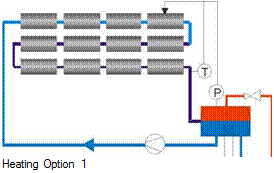Solar augentation of drying process
The strip dryers are operated with steam at 9 bar and have a capacity of 174 kW each. The advantage of this option is that all steam produced by the pilot plant can be utilized by a single consumer at all times, without the need to implement an additional storage. However, the 9 bar pressure level implies lower collector efficiencies and longer start-up times in comparison to the 4 bar applications. This drawback will be amplified by the solar radiation conditions at the given site, which will lead to significant proportion of part-load operation. Since the drying process is particularly sensitive for the product quality, this application was not considered appropriate for a first-of it’s kind demonstration plant.
Direct solar steam supply to the new production line
The current extension of the production facilities provides favourable conditions for the implementation of additional piping and heat exchangers for the solar steam into the degreasing and sealing baths and storage tank. Such a dedicated solar heating system would allow more flexibility for optimized operation of the solar field. It could be operated at temperatures little above the desired bath temperatures, and allow, in principle, even the implementation of nontracking medium temperature collectors like CPC, vacuum tube or double glazed flat plate collectors as described by Rommel et al. [3] with pressurized water as the heat transfer medium.
Figure 2 shows the hydraulic scheme for the direct supply of individual consumers by dedicated heat exchangers from the solar system. The solar field is operated in recirculation mode. Water from the bottom of the steam drum is pumped through the collectors, where a proportion depending on the solar input is evaporated. The water/steam mixture is returned to the drum where
it is separated by gravitation. Saturated steam is extracted through a pressure control valve and directed to the consumers. To ensure appropriate temperature levels in the process at all times, the solar heat supply will be backed up by heat exchangers fed by the conventional steam system (not indicated in Fig. 2), connected in series to the solar heat exchangers. The condensate is collected and pumped back to the steam drum. An expansion vessel is integrated into the system to compensate for the different volumes of water and steam in the cold and operation conditions, respectively. Auxiliary heating for freeze protection could be integrated into the steam drum or the condensate vessel.
 Roof level
Roof level
Installation level
Consumer 1 Consumer 2
|
|
|
|
|
|
|
|
|
![]()
![]()


Fig. 2: Hydraulic scheme of direct solar steam supply to individual consumers
Operating the solar system as an independent closed loop has several benefits. The conventional steam system cannot be jeopardized by transient insolation, condensate quality or fluctuating pressure from the solar system. Reducing the pressure and temperature may increase the of the collector efficiency by several percent.
On the other hand, the base load consumption of the new production line is too low to guarantee direct utilization of the solar steam (compare table 1). Therefore, costly steam storage would have to be integrated, or additional consumers need to be connected. Steam and condensate piping to several more or less distant consumers will not only increase the necessary investment but also cause thermal losses which may partly compensate the potential benefits from the reduced temperature operation of the solar field. Parallel steam supply from solar and conventional boiler system to the various consumers does also imply duplication of controls, leakage detection and
feedwater treatment, altogether leading to prohibitively high additional cost on top of the solar system.